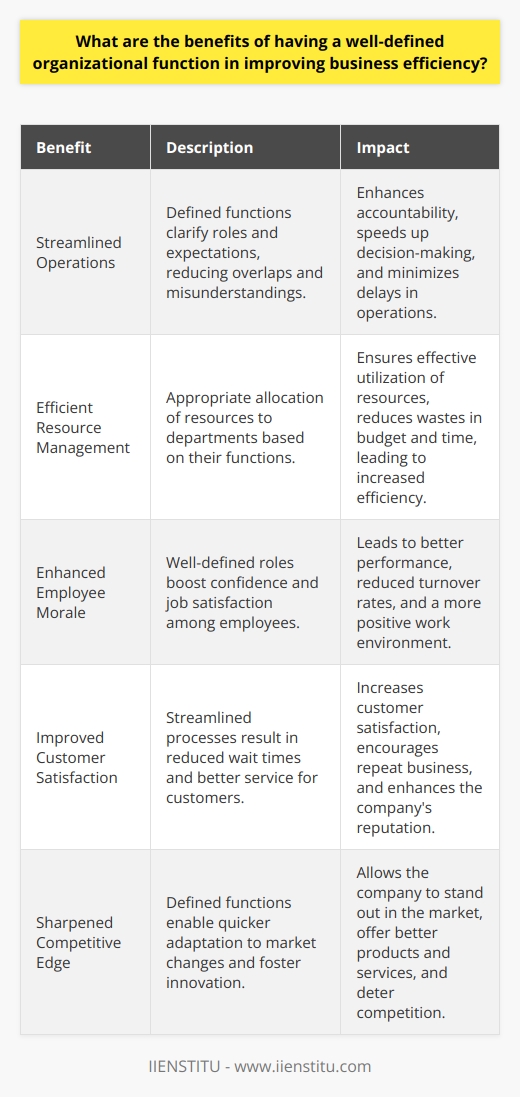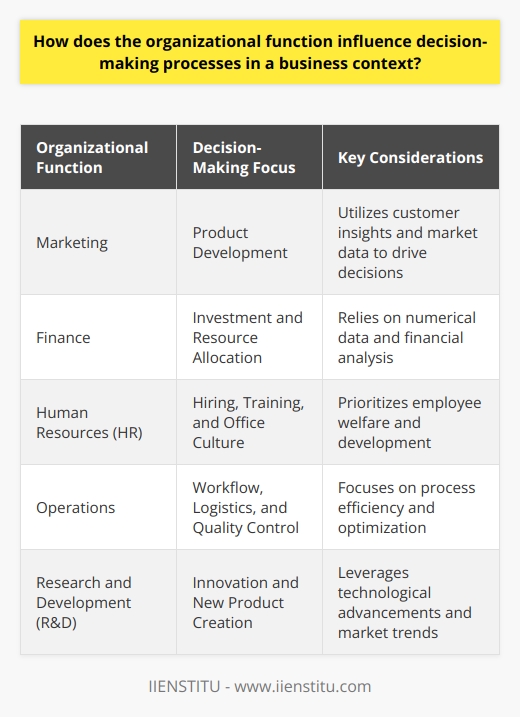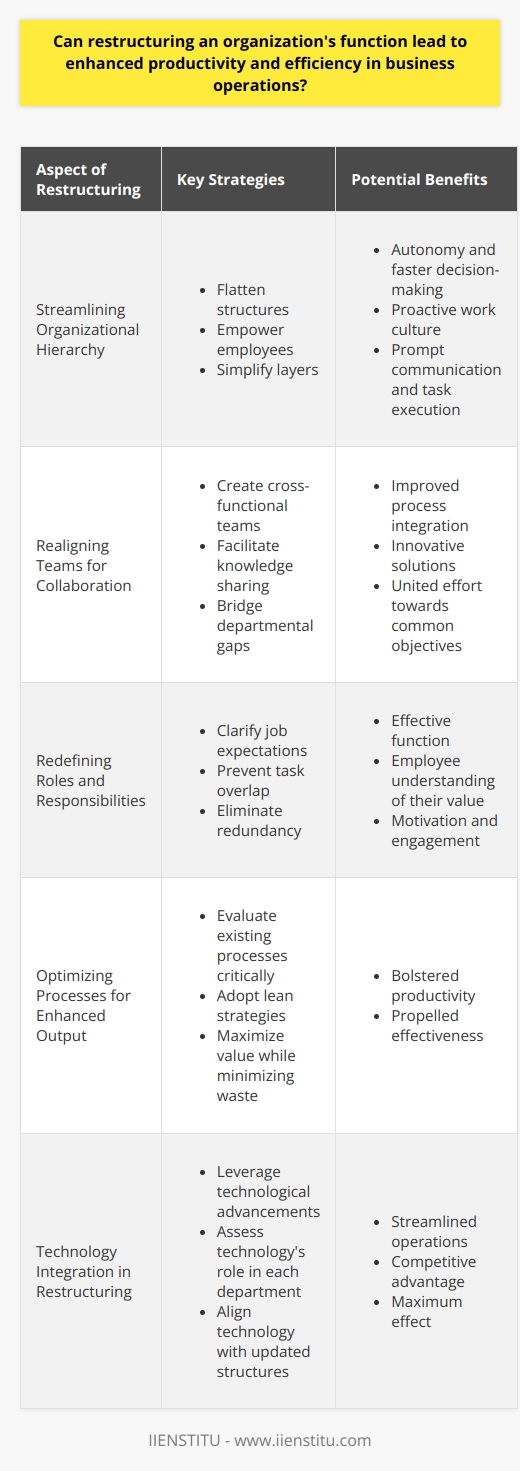
The intricacies of organizational function are paramount in laying the foundation for business efficiency. At its core, organizational function encompasses the systematic methods through which a company orchestrates its resources to achieve strategic objectives. This convergence of structure, processes, and roles is critical in steering organizations towards success. In the current pace of global business, streamlining processes is not just an option, but a necessity for survival and prosperity.
Efficient operations are the lifeblood of productive companies, where organizational structure plays a strategic role in facilitating seamless workflow, communication, and decision-making. For individuals and professionals seeking to expand their understanding and expertise in this domain, pursuing an MBA degree or enrolling in online courses with certificates can be invaluable investments.
Understanding Organizational Function and Structure
The term 'organizational structure' refers to the layout of power, responsibilities, and roles within a company. It is a silent director, guiding the symphony of tasks and employees towards the company's mission. A well-designed structure is both a blueprint and a roadmap, reflecting the organization's objectives and how it plans to reach them. There are numerous forms of structures, each with unique features that influence organizational behavior and effectiveness.
Within the various structural paradigms such as hierarchical, flat, or matrix configurations, the chosen framework significantly impacts business efficiency. A hierarchical structure might benefit large, complex organizations requiring stringent control, while a flat architecture could foster faster decision-making and innovation in smaller, more agile enterprises. Then there's the matrix structure, encapsulating a dual-reporting system to optimally leverage resources across different project dimensions. Each structure carries its own merits and challenges but is united in the goal of clarifying roles and streamlining functions to boost efficiency.
Crystal-clear definition of organizational functions within the structure is pivotal. Such clarity couples the right people with appropriate tasks, aligning with corporate vision. This precise matching is not only about efficiency; it's about empowering team members with a sense of purpose and direction, which is instrumental in robust decision-making and process maneuvering.
The Dynamics of Streamlining Processes for Enhanced Efficiency
Assessing and Remodeling Business Processes
Business process efficiency is akin to a pulse, indicating the health and vitality of an organization's operational flow. In assessing current processes, companies must take a microscope to their activities, evaluating their effectiveness and identifying any bottlenecks or redundancies that lead to waste—a detrimental factor to efficiency. Such scrutiny often reveals the need for a redesign or refinement of certain practices.
Strategies for identifying the wastage in processes often involve mapping out procedures, a critical reflection that enables businesses to visualize where delays or unnecessary steps occur. After laying out the territory, methods such as lean management or Six Sigma can be applied to remodel processes, where the aim is to eliminate waste and enhance value to the customer. This reconfiguration is not about mere procedure; it's about building a culture that thrives on continuous improvement and excellence.
Role of Technology in Process Optimization
In the quest for streamlined operations, technology stands out as a significant enabler. With the right technological tools, businesses can automate mundane tasks, reduce errors, and gather data that provide insights into further optimization opportunities. Software solutions—ranging from Customer Relationship Management (CRM) to Enterprise Resource Planning (ERP) systems—offer pivotal advantages in refining the cogs of the business machinery.
These technological aids not only improve efficiency but can also lead to innovation in service delivery and product development. For instance, Artificial Intelligence (AI) can now predict customer trends, blockchains provide undeniable provenance, and the Internet of Things (IoT) offers unprecedented connectivity. Each technological progression redefines what it means to be efficient in today's business landscape.
Achieving Operational Efficiency through Organizational Function
The Significance of a Cohesive Organizational Structure
Operational efficiency is the cumulative result of well-placed organizational functions within a coherent structure. When each cog in the machine knows its role and how it contributes to the overarching goals, productivity rises. However, a structure alone isn't enough—it must be embedded within a culture that values and supports its coherence.
Organizational culture acts as the environment in which the business's operations flourish or flounder. If the culture is toxic or resistant to the structure, inefficiencies will inevitably surface. Conversely, a supportive culture—one that encourages collaboration, innovation, and efficiency—grounds the structure and functions in a context that is conducive to growth and achievement.
Training and Development for Organizational Efficiency
Training and employee development are not expenses; they're investments. By increasing the capacity of team members to perform their organizational functions effectively, companies can reap dividends in the form of efficiency. This interrelation between staff expertise and smooth organizational operations cannot be overstated.
A comprehensive training regime ensures that employees are not only skilled but also adaptable to change—which is constant in the business environment. Here, enrichment opportunities such as obtaining an MBA degree or certification through relevant online courses with certificates emerge as crucial tools in sustaining and expanding workforce capability.
Application of Organizational Function in Various Business Sectors
In the diverse expanse of the business world, from manufacturing to the service industry, optimizing organizational function exerts a universal appeal for amplifying efficiency. Case studies across various sectors demonstrate how companies reap substantial rewards by re-engineering their structures and processes. A manufacturer might leverage a new CRM to respond rapidly to market demands, while a tech company may embrace a flat structure to accelerate innovation.
Each sector approaches the challenge of efficiency with its distinct tools and methods but shares the same guiding principle—to tailor organizational functions towards greater productivity. As business landscapes evolve, the pursuit for efficiency breeds novel strategies and even entirely new organizational forms.
In this journey through the role of organizational function, we have explored its vital significance in forging paths toward business efficiency. From the deliberate shaping of an organization's structure to the methodical streamlining of processes, the pursuit of operational efficiency is relentless and multifaceted. As we move forward, it remains crucial for leaders and managers to continuously assess and adapt their organizational frameworks, integrating new technologies and fostering cultures that support dynamic efficiency. Given the rapid changes in the global business arena, the reflection upon one's organizational structure and the drive for improvement is not merely an academic exercise but a practical necessity in thriving within the competitive marketplace.
Frequently Asked Questions
What are the benefits of having a well-defined organizational function in improving business efficiency?
Understanding Organizational Functions
An organization thrives on clarity. Defined functions streamline operations. They foster effective resource utilization. Roles turn clearer. Employees understand expectations. This enhances accountability.
Efficiency in Resource Management
Resource allocation improves with defined functions. Departments receive appropriate resources. This ensures effective utilization. Overlap between departments diminishes. Wastes in budget and time decrease. Efficiency becomes inevitable.
Streamlined Communication
Clarity in communication stands crucial. Defined functions improve information flow. Messages travel to correct destinations faster. Misunderstandings occur less frequently. Decision-making speeds up. Overall, operations experience fewer delays.
Enhanced Employee Morale
Well-defined roles boost morale. Employees feel confident. They know their responsibilities. Job satisfaction often rises. Higher morale leads to better performance. It also decreases turnover rates.
Improved Customer Satisfaction
Efficiency affects customer experiences. Streamlined processes reduce wait times. Customers enjoy better service. Their satisfaction reflects on the business's reputation. Positive experiences invite repeat business.
Sharpened Competitive Edge
Defined functions sharpen competitive advantages. They enable quicker adaptation to market changes. Businesses with agility stand out. They offer better products and services. Innovation becomes part of the culture.
Focus on Core Competencies
Organizations can focus on strengths. Clear functions allow specialization. Teams build expertise. They deliver higher quality. This focus attracts customers. It also deters competition.
Simplified Decision-Making
Decision-making simplifies. Leaders have clear information. They understand department capabilities. Risks reduce. Decisions become more strategic. The business responds adeptly to challenges.
Reduced Operational Costs
Efficient processes cut costs. Duplication of work lessens. Productivity increases without extra expenses. Profits can soar. Investments in growth become feasible.
Talent Attraction and Retention
Talented individuals seek well-run organizations. Defined functions hint at stability. They suggest growth potential. The best talents align with such companies. They often stay longer.
A well-defined organizational function bridges many gaps. It touches every aspect of business efficiency. It not only saves time and money. It also builds the foundation for a resilient, innovative, and competitive business. This becomes an essential strategy in a fast-paced, ever-evolving market landscape.

How does the organizational function influence decision-making processes in a business context?
Organizational Function and Decision-Making Processes
Organizational function significantly shapes how businesses make decisions. Each function within an organization contributes uniquely to the decision-making fabric. Underpinning these functions are their distinct roles, responsibilities, and information flows.
Decision-making in Various Organizational Functions
Marketing, for example, prioritizes customer insights. It uses market data to drive product development decisions.
Finance, in contrast, focuses on numerical data. It influences decisions on investment and resource allocation.
Human Resources (HR) considers employee welfare. It shapes decisions on hiring, training, and office culture.
Operations deals with process efficiency. It affects decisions on workflow, logistics, and quality control.
The Influence of Organizational Structure
Decentralized structures empower individual departments. These units can make swift, autonomous decisions. But, this autonomy often requires strong inter-departmental communication to avoid siloes.
Centralized structures bring decision-making to the core. Here, consistency and alignment across the company take precedence. Yet, agility and localized decision-making can suffer.
Organizational Culture and Decision Style
Organizational culture sets the behavioral framework. It molds decision-making styles, whether analytical or intuitive.
- Analytical cultures value data and detailed analysis.
- Intuitive cultures rely on experience and gut feelings.
Information and Communication Pathways
Clear information pathways accelerate decision-making. They ensure relevant data reach decision-makers quickly. Conversely, poor communication bottlenecks decision processes. It creates information gaps and slows responsiveness.
Adaptability and Learning
Dynamic organizations adapt their decision-making over time. They learn from past outcomes to inform future choices. This adaptability allows for refinement and improvement in decision processes.
Conclusion
Organizational function plays a pivotal role in business decision-making. It dictates what information is crucial and who makes the decisions.
Each function adds a unique perspective. Together, they mesh into the broader decision-making apparatus. Understanding this interplay is vital for organizational success.

Can restructuring an organization's function lead to enhanced productivity and efficiency in business operations?
The Potential of Organizational Restructuring
Reconfiguring an organizational structure often yields substantial benefits. Through the lens of theory and practice, the concept of restructuring embodies a strategic realignment. It targets improved operational workflows. Restructuring aims to enhance organizational agility. It touches upon divisions, departments, and individual roles.
Streamlining Organizational Hierarchy
Analyze the hierarchical layout for potential improvements. Flatter structures promote autonomy and faster decision-making. Empower employees with responsibility. This often fosters a proactive work culture. Simplify layers. Ensure prompt communication and task execution.
Realigning Teams for Collaboration
Create cross-functional teams. They improve process integration. These teams facilitate knowledge sharing. They also spawn innovative solutions. Collaborations like these bridge departmental gaps. They forge a united effort towards common objectives.
Redefining Roles and Responsibilities
Clarify job expectations. It is crucial for effective function. Clear definitions prevent task overlap. They eliminate redundancy. Employees understand their value better. This breeds motivation and engagement.
Optimizing Processes for Enhanced Output
Evaluate existing processes critically. Discard outdated, inefficient methods. Adopt lean strategies. Lean methodologies maximize value while minimizing waste. They bolster productivity and propel effectiveness.
Technology Integration in Restructuring
Leverage technological advancements. Integrating new tech streamlines operations. It ensures competitive advantage. Assess technology's role in each department. Align it with updated structures for maximum effect.
Reflection on Restructuring Benefits
Upon restructuring effectively, organizations experience notable advancements. They report heightened productivity. Efficiencies across businesses operations are common outcomes. However, success requires strategic planning. Include all stakeholders in this process. Deploy change management practices. Track progress and adapt as necessary.
In conclusion, restructuring an organization's function can indeed enhance productivity and efficiency. The pursuit of such a goal demands careful consideration. It requires nuanced implementation. When executed with precision, restructuring stands as a bastion of operational excellence.



